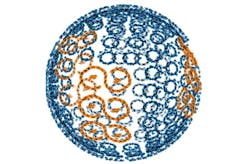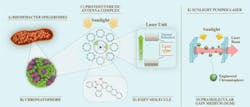Bio-inspired approach to harvest sunlight and convert it into laser beams in space
The challenge of efficiently harvesting and transmitting solar power within space poses a critical bottleneck for ambitious space exploration plans. Current space-based solar power systems rely on photovoltaic panels to convert sunlight to electricity. But these components have limited lifespans under harsh space conditions and can’t easily be replaced or scaled up without a supply line from Earth. Electricity itself is also difficult to distribute within a space environment. One idea for power transmission is via laser beams generated by electrically powered solid-state lasers.
But what if we could power space missions by piggybacking onto the same efficient light-harvesting technique photosynthetic bacteria managed to perfect during billions of years of evolution? It's exactly what our international team of scientists—including Heriot-Watt University in Scotland and led by Professor Giuseppe Luca Celardo at the University of Florence in Italy—is working to achieve through an innovative €4 million ($4.1M) research project that could transform how we power everything from satellites to lunar bases.
The APACE project seeks to create the first sunlight-pumped laser to leverage the extraordinary light-capture capabilities of photosynthetic bacteria to achieve direct conversion of sunlight into coherent laser beams, which is ideally suited for long-distance power transmission.
Nature's ability to harvest light
At the heart of our research is the remarkable efficiency of bacterial photosynthetic systems. Certain anaerobic bacteria have evolved to thrive in extremely low-light conditions and developed highly sophisticated molecular antenna complexes that can channel and convert almost every photon they capture.
APACE targets two types of bacteria known as purple bacteria and green sulfur bacteria (see Fig. 1). They use specialized structures called antenna complexes to capture light. These natural antennas are incredibly sophisticated at the molecular level. Each one contains thousands of light-capturing molecules arranged in precise patterns that funnel energy to a central collection point with almost no losses.
What makes these bacterial antennas so special? Their ability to focus light energy at the nanoscale means they act like microscopic solar concentrators. But instead of using traditional mirrors or lenses and the laws of ray optics, they use quantum effects to channel the energy in ambient light efficiently to the focal point of the reaction center through their densely packed network of molecules.
Novel type of laser gain medium
The APACE project’s goal is to harness this natural bacterial efficiency by creating a novel type of laser gain medium that combines such modified bacterial light-harvesting complexes with carefully designed lasing units. Our team is pursuing multiple parallel strategies to maximize the chances of success.
We’ll explore two types of natural antenna systems: chromatophores from purple bacteria and chlorosome-baseplate-FMO complexes from green sulfur bacteria (see Fig. 2). They will be further complemented by artificial antenna systems that mimic the natural light-harvesting structures.
For lasing units, our team is also exploring multiple options in parallel, ranging from designs building on well-established lasing materials to ideas for more bespoke proprietary solutions with properties specially designed for the unique working conditions of our design.
One crucial challenge will be how exactly to synthesize the extracted antenna structures with the lasing units in a way that allows for an efficient energy transfer between these two core components. Further, the design of the lasing cavity—including its geometrical dimensions and arrangement—represents another vital line of investigation we have begun to tackle by building on the world-leading expertise of our consortium members from the Karlsruhe Institute of Technology and the Max Planck Institute for the Science of Light.
A radical approach for energy transfer efficiency
The APACE concept represents a significant departure from existing sunlight-pumped laser technologies. Current state-of-the-art systems require solar concentration factors of around 1000 to achieve solar collecting efficiencies of just 4%. The need for large concentrating optics and sophisticated cooling systems has limited their practical use and presents particular limitations for use within space.
In contrast, our bio-inspired approach aims to achieve lasing under unconcentrated sunlight by exploiting the natural light-concentration capability of the photosynthetic antenna complexes. The idea is that the resulting lasing devices will be lightweight, with organic components that could be grown, sustained, and recycled at the site of use.
Our team projects potential energy transfer efficiencies from antenna to lasing unit so that up to nearly one in two absorbed solar photons manage to contribute to pumping the gain medium comprised of the lasing units. Overall system efficiencies are expected to reach 1 to 10%, and represent an improvement of 2 to 3 orders of magnitude over a recently demonstrated sunlight-pumped laser that was the first ever to operate with unconcentrated sunlight.
But raw efficiency is not necessarily the most important characteristic of such a light-harvesting technology. Once good enough to be a viable technology, considerations such as robustness, sustainability, and especially the output power to weight ratio of the technology may matter far more—especially for situations where there is plenty of space.
Space applications and Earth-based energy systems
The most obvious appeal for this technology is for space power applications. The ability to directly convert sunlight into laser beams without intermediate electrical conversion could enable more efficient wireless power transmission between satellites, from satellites to lunar bases, or even back to Earth. The system's simplicity compared to conventional approaches—eliminating the need for photovoltaic panels, electrical systems, and complex optical concentration—makes it particularly attractive for space applications where reliability is paramount.
Through studies on the International Space Station, we already know it is possible to grow bacteria in space, with some tough bacteria surviving exposure in open space. If our new technology can be built and used on space stations, it could help generate power locally and even offer a route for sending power to satellites or back to Earth using infrared laser beams.
Its potential impact also extends beyond space applications. Our research could lead to advances in fields ranging from integrated photonics to bio-inspired quantum technologies. The team is already exploring potential applications in sensing devices and novel integrated optoelectronic chips.
We set challenging milestones throughout the project’s lifetime, beginning with achieving suitable lasing units and being able to synthesize and demonstrate a supermolecular gain medium. This involves the combination of the two different functionalities of capturing sunlight and generating ultralow-threshold laser light. We aim to have these ready within about two and a half years.
Within three and a half years, our goal is to have a working microlaser that can take sunlight and upgrade it into a laser beam, albeit still within a lab setting with low power output. Then, by the end of the four-year project, our most ambitious goal is to turn it into a macro laser, which produces more power, can be scaled up, and used within different environments.
The APACE consortium brings together nine European research institutions, combining expertise in quantum biology, laser physics, synthetic organic chemistry, spectroscopy, nanotechnology, and space engineering. The project is jointly funded by the European Innovation Council and Innovate U.K.
As space agencies worldwide develop plans for ambitious missions to the Moon and Mars, the need for efficient, reliable power systems becomes increasingly critical. Our bio-inspired approach to sunlight-pumped lasers could provide a key enabling technology for sustainable space exploration and open new pathways for terrestrial applications in wireless power transmission and sustainable energy solutions.
About the Author
Erik Gauger
Erik Gauger is a professor in the Institute of Photonics and Quantum Sciences at Heriot-Watt University, where he leads the quantum theory team.

